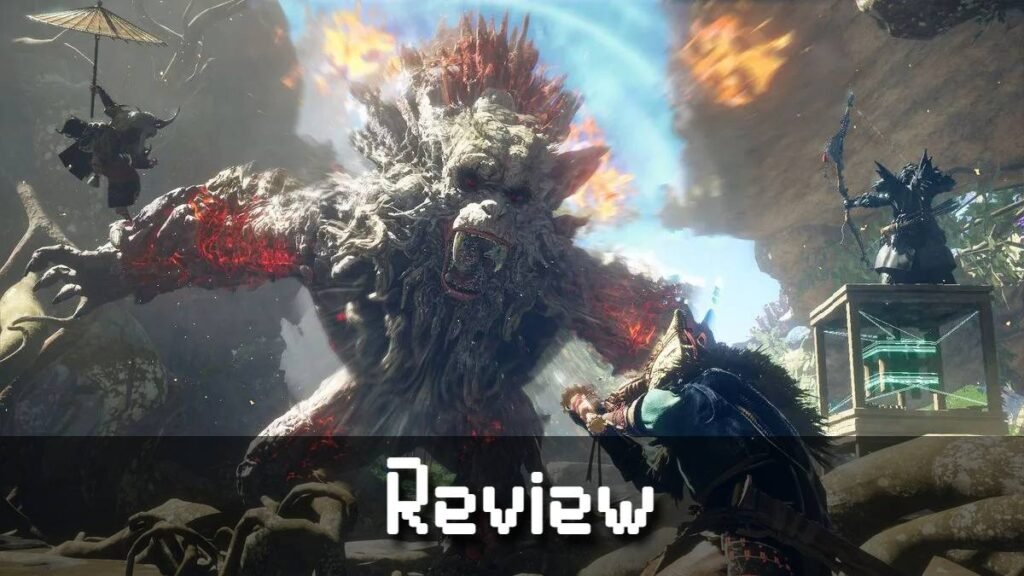Welcome to the game review, this is often more of an informational Post about all or any more details of the Wild Hearts Game review and what we all know so far.

Wild Hearts Story
Wild Hearts is a Monster Hunter-style game brought to us by the team behind Dynasty warriors Koitekmo and Omega Force. This time, though, it’s being published by EA under their EA Originals brand.
Upfront, I just want to say that comparison toCapcom’s Monster Hunter series is honestly just unavoidable. At the same time, though, that series is also incredibly relevant to this review, so I guess we’ll just go with it.
Wild Hearts Game Review: Wild Hearts is set in the mystical land of Azima, a fantasy version of feudal Japan overrun by huge beasts known as Kimono. At the start of the game, you’ll be able to create your very own custom, Hunter. It’s the job and the duty of the hunters in this world to take down the kimono and keep the city of Minato safe.
There are, of course, more story beats, character interactions, side quests, and hunting jobs to accept, but as usual, I’m not going to spoil anything here. I’ll also only be showing footage from the very first area and a very small amount from the second, so you don’t have to worry about seeing too much.
Wild Hearts Gameplay
As mentioned previously, the gameplay loop and the overall structure is very similar to what you’d find in the Monster Hunter series. Its closest comparison is probably Monster Hunter World, due to the large, intricate open zones that include roaming monsters and dense geometry. You could probably set it alongside other lesser-known games like Tokydin or God Eater, but I think World is easily the closest comparison.
Structurally, the game can be split into three sections. You’ve got the open zones where the hunts take place, the hub city of Minato, and the smaller customizable campsites that you can create within the game world.
Minato City is pretty much the only safe place left for citizens in this region. Perched precariously atop a large mountain, it’s home to many hunters and is relatively inaccessible to most Kimona. Although they are getting closer every day, it functions as a hub for the player, allowing you to create new gear or upgrade existing pieces and buy and sell items or take on commissions.
As you might expect, you’ll be able to accept both main quests and sidequests from various NPCs within this city.
- Main quests progress the story and move the narrative along, which in turn unlocks new areas to explore and new Kimono to hunt.
- Side quests are obviously going to be quicker to complete, and while they do have varied objectives, it usually comes down to simply exploring, gathering, and hunting.
Wild Hearts Game Review: The open zone biomes are rather large. They have a lot of smaller areas within themselves, hidden locations, and a lot of verticalities. During your hunts, you’ll discover a few valuable items and features in the wild things like thread, which we’ll talk about later, glowing trees that fully restore your health potions, and most notably, campsites.
These campsites can be built around dragon pits that you find spread out across the game’s environments. After being activated, you can build small camps and create useful utilities around that Dragon Pit. You can then upgrade the pit itself, allowing you to build more items around it than you could before. Building tents at these locations also unlocks the ability to fast travel between them and change the time of day.
Wild Hearts Multiplayer
I do want to briefly mention the multiplayer here, and I’ll be able to do that rather quickly because it’s as simple as pressing a single button. Gone are the convoluted party mechanics of Monster Hunter World, replaced with a system that lets you press a single button to invite two other random players into your hunt.
Once the hunt is complete, they will automatically leave the group again after a short time. It’s also worth mentioning that you can simply invite friends into your group as well without having to set up anything specific. Just invite them and they can join. It’s as simple as that.
At launch, Wild Hearts includes 21 giant beasties to slay and harvest for parts. It does sound a little bit mean, but the developers themselves said they wanted the Kimono to feel like a threat so that the players wouldn’t feel guilty for killing them, which makes sense, I suppose. That may seem like a small number of monsters, but it is confirmed that more Kimono will be added to the game later at no extra cost, which is a nice touch.
Wild Hearts Abilities
Each Kimono has its own unique abilities, attacks, weaknesses, and personality, which can all be exploited in some way to turn the tides of battle. Once enough damage has been inflicted, a Kimonowill become enraged, which essentially powers them up.
They’ll hit harder, use new powerful attacks, and sometimes change the location of their weak point. They will eventually calm down and return to normal so that you can continue your assault. And when you’ve dealt significant damage, they’ll often retreat and limp away in an attempt to recover. At that point, your goal is to track them to their nest and take them down.
In order to defeat these beasts, you’re going to need to make proper use of your weapons, your gear, and, crucially, your Karakuri.In the real world.
Karakuri were originally traditional Japanese mechanized devices, usually made from wood, and they use thread to make them move. Obviously nowadays Karakuri is much more advanced and made from stronger materials, but the game takes inspiration from the older versions that you’d find in feudal Japan.
Wild Hearts Game Review: As you explore the world, you’ll have a lot of opportunities to harvest thread from rocks, trees, and the Kimono itself. Your thread counter is located at the bottom of the screen in the center, and it’s used to pay for the construction of various Karakuri. There are a lot of different types to unlock and make use of some help with exploration.
Some are geared toward combat, and a few of them have multiple useful functions as a few examples. You can create simple boxes which can be stacked and climbed, allowing you to execute a powerful plunging attack on the unfortunate monster. Below, there are springboards that help you avoid danger or close distance quickly, a torch that coats your weapons in flame when you get close to it, and a launcher that allows you to create zip lines across the terrain.
Most of the battle focus constructs can be interacted with automatically by simply moving into them, whichmakes them quick and easy to use. The items I’ve just described are known as the more simple Karakuri. However, during a hunt, you’ll occasionally get flashes of inspiration, which show up as a simple button prompt.
When this prompt is completed, it unlocks a more advanced type of Karakuri. The advanced versions do consume more thread, but they are much stronger than the basic variants. Something interesting to note is that the Karakuri you place in the world is persistent, meaning that they’ll stay there wherever you build them, even if you leave the area and come back later.
This is important because you could, for example, build a zip line that links a tall mountain and the starting area of a specific map. You’ve essentially just created a custom shortcut, and it’ll stay there as long as you want it to. If a Kimono happens to cross its path and break it, though, it will actually rebuild itself automatically, so you need not worry about losing it.
This system allows you to really customize the environment to your needs and plot-efficient routes through the landscape. Any hunters worth their salt are going to need strong weapons and gear in order to take down the toughest beasts. The game features eight unique weapon types, each with its own special abilities, attacks, strengths, and weaknesses.
The great sword hits like a train, for example, but it’s got a very slow swing speed and recovery time. Using the Katana, however, makes your hunter more agile. The weapon hits for less damage, but it also strikes way more often. You can actually forge multiple weapons of the same type and then follow different upgrade paths.
This means that you can effectively create multiple versions of your favorite weapon, with each of them serving a different purpose. This process requires the acquisition of different kimono parts that you obtain from hunts. The components can then be spent on each weapon’s extensive upgrade tree. There’s a lot of flexibility and customization available within each upgrade tree, although the best upgrades do expect you to grind for them.
Wild Hearts Armor
Armor is created in a very similar way, meaning that you can forge it when you have the necessary parts available.
Each piece, as you might imagine, has stats such as defense and resistance to specific types of damage, like water and fire. Ideally, when you know which Kimono you’re hunting, you’d equip a weapon and armor that gives you an advantage against that specific monster.
Armor can also be altered or modified to fit a certain path alignment. Path Alignment is a sliding scale that moves depending on how much of your armor has been modified to fit that path.
The alignment governs which skills on certain pieces of armor can be activated. There are five points to the scale which are centered human, pure human kimono, and pure kimono. Some armor pieces will have a skill builtin that can only be activated if your character is in the right alignment.
So with that in mind, it makes sense that some of the more powerful skills might require your character to be completely decked out in armor of a certain alignment. On top of all of this, you’re also able to equip talismans that grant passive bonuses and also cosmetics to change the appearance of your gear.
Wild Hearts Performance & Testing
I played this on PS5 and I used performance mode exclusively. This mode targets 60 FPS, and I believe it’s locked to a 1080p resolution. In my experience, there were definitely frame drops here and there, especially during heavy combat, but it was never anything that felt unplayable. Your mileage may vary, of course, but my playthrough was absolutely fine.
Wild Hearts Game Review: The game also includes a Fidelity mode that runs at tested briefly for the review, and it seems to run at 30 FPS or under, even when you’re barely doing anything. So I absolutely do not recommend playing the game in this mode, but as always, the choice is yours.
Wild Hearts Platforms
The game is available right now on PS5, Xbox series, and PC, but it’s worth pointing out that it’s not coming to last-generation systems. Physical copies are widely available for PS5 and Series X, and you can try out the demo version of the game if you have an EA Play subscription.













